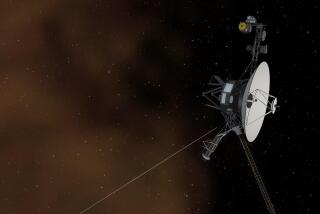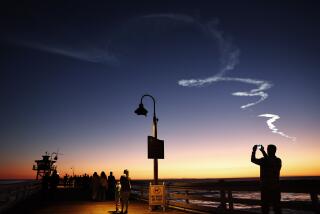Phoenix lander’s work on Mars is delayed by a radio glitch
Prospecting near Mars’ north pole was set back at least a day Tuesday when a communications link to NASA’s Phoenix lander, nestled into a wide, undulating expanse nicknamed Green Valley, was interrupted by what spacecraft operators called a “transient event.”
The event, caused by a cosmic ray or some other high-energy particle, knocked out the UHF radio on the Mars Reconnaissance Orbiter, one of two NASA spacecraft circling Mars that relay computer commands between Phoenix and Earth.
The interruption occurred as operators were attempting to test the nearly 8-foot-long robotic arm that is to begin digging into the Martian plain sometime in the next few days.
Lying just inches below the lander are thought to be rich deposits of ice that could provide clues to whether Mars once was, or still might be, habitable for simple life forms.
Fuk Li, manager of the Mars Exploration Program at the Jet Propulsion Laboratory in La Cañada Flintridge, emphasized that the problem did not affect the lander.
“Phoenix is healthy; everything is fine,” he said.
The radio problem was fixed later in the day, and the orbiter resumed relaying the lander’s images of the Martian landscape back to Earth, NASA officials said.
NASA also can uplink commands to another orbiting spacecraft, Mars Odyssey, which can pass them on to Phoenix.
Operators late Tuesday decided to send commands through Odyssey to move the lander’s robotic arm.
Phoenix arrived on Mars on Sunday after a 296-day journey. The $420-million mission is the first to successfully land on Martian soil since the arrival of NASA’s twin rovers, Spirit and Opportunity, in January 2004.
Before the problem occurred, Phoenix’s mast camera, extending about 7 feet above the Martian surface, took new pictures of the terrain, capturing fresh images of the checkerboard landscape of ridges and troughs believed to be caused by the movement of the ice beneath the surface. Scientists hope to dig into one of those troughs to unravel the history of water on Mars.
Scientists know water is key to life as humans understand it, and Phoenix is the first spacecraft to travel to another planet to explore water directly.
The craft will dig into the soil and ice, then bake some of the material in tiny ovens to search for organic molecules -- those containing carbon and hydrogen -- as well as evidence that the water was once in liquid form.
That would have provided a medium for organic compounds to combine into the building blocks of life.
Also Tuesday, NASA released pictures taken by the orbiter’s high-resolution camera that showed Phoenix sitting on the surface a few hundred feet from its parachute.
The lander is about 12 miles from what scientists call Heimdall crater and 30 miles from a set of low-lying hills.
Scientists have dubbed the spot Green Valley not because it’s green, but because it proved to be a safe place to land.
Phoenix also sent back a weather report for its lonely home 171 million miles from Earth. The temperature ranges from minus-22 degrees Fahrenheit at midday to minus-112 degrees in the early morning. Because it’s spring on Mars, the sun never quite sets on the northern pole, so as cold as it is, it will get even colder when winter arrives.
Carbon dioxide snow will eventually cover the lander, snuffing out its life -- though not before, it is hoped, it finishes its work.
The wind is blowing about 13 mph from the northeast.
Phoenix’s mast camera also took a picture of a DVD that was attached to the science platform by the Planetary Society in Pasadena.
The disc contains the names of thousands of people, as well as a library of Mars-related books. The cover reads, “Astronauts, please take this with you.”
Made of high-quality silica glass, the disc should survive, even in Mars’ cold atmosphere, for “hundreds and hundreds of years,” said Louis Friedman, the society’s executive director.
“We hope the astronauts don’t take that long,” he said.
More to Read
Sign up for Essential California
The most important California stories and recommendations in your inbox every morning.
You may occasionally receive promotional content from the Los Angeles Times.










